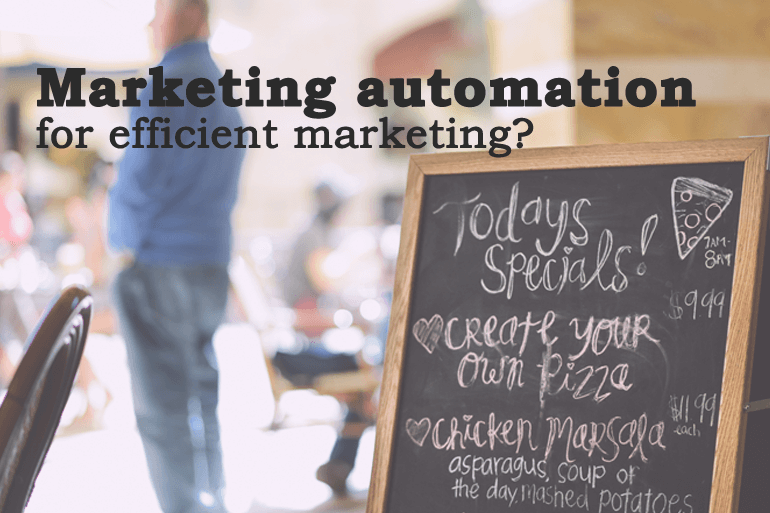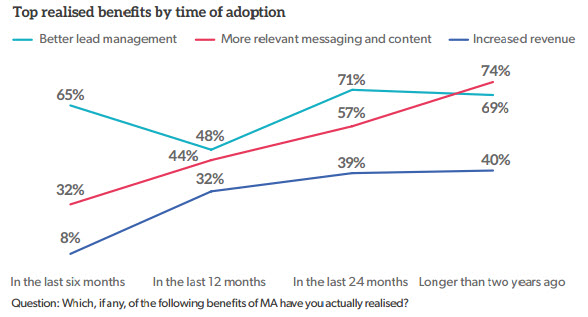Marketing teams all around the world are looking to be lean, mean and efficient. They want to spend their budget most efficiently. In other words, they want to get the most bang for their buck. And they want figures to prove it. Increase productivity? Raise KPI? Win more sales? Yes, please.
Enter marketing automation
Marketing automation providers serves to fulfil these ambitions of marketers. It has evolved over time from a software solely designed to automate email marketing to marketing platforms that enable marketers to easily manage all their marketing activities and automate repetitive tasks. With rules and workflows, segmentation and targeting, marketing automation enables marketers to impact their customers with the right message, at the right place and time.
The adoption of marketing automation has since soared through the roof. Yet the market offers a lot more potential. For starters, 59% of B2B Fortune 500 Companies use marketing automation. This means a large percentage of the most profitable companies in the world are still not using marketing automation at all. Furthermore, out of those who use marketing automation, many struggle with harvesting the full potential of their technologies. Studies reveal that majority consider their marketing automation capabilities to be basic.
Making the first step of moving or switch to a marketing automation tool can be a big struggle for many organisations. The setup phase is costly. Integrating marketing automation into your IT infrastructure, migrating data, setting up new processes and workflows and getting staff trained requires time and resources. On top of that, marketers gamble the risk of implementing a technology that does not meet their expectations when it comes to capacity and capabilities.
Is marketing automation worth the effort?
The heat is on in the marketing world. Marketers are facing the pressure of getting the full picture of their customers’ behaviour across channels and devices, in order to reach them at the right phase with the right messages. Marketers need to provide value in their messages and direct them towards checkout without being overly pushy. Every marketing team tries to compete on who does this better – and more will do better in 2017.
Therefore, despite the initial struggle with the switch, marketing automation is very often worth the effort indeed. Among the reasons listed by Econsultancy on why companies would adopt marketing adoption are:
Better data collection for better targeting
With marketing automation, marketers can automatically produce touchpoints to customers that are not directly sales-driven. But these touchpoints can be used to collect specific data, gathered to provide better insights on the customers and thereby be used to improve future campaigns or communication to customers.
Customers’ big picture
Marketing automation helps marketers keep track of the marketing activities taking place across channels and devices. This draws a more complete picture of their customers, enabling marketers to draw more accurate insights.
Save time and resources
Marketing automation enables marketers to communicate with their partners and clients more efficiently. This means being more productive and being able to focus on new projects with their working hours. While the set-up is hard, time and resources – and thereby costs – are reduced over time.
As EmailMonday reports, only 8% of companies see increased revenues within 6 months of adopting marketing automation. After one year, 32% claim to see increased revenue. For those to have been using it for more than two years the figure is 40%.
Your next 3 steps for Marketing Automation with results
1. Decide whether marketing automation is suitable for your business
Marketing automation isn’t for everyone. These questions from VentureBeat can help guide you along the way: Does your team have the marketing skills necessary to take true advantage of it? Do you have sufficient leads that could feed into the marketing automation processes you’ll define? Is your CRM tool good enough to close all the leads you are nurturing? Do you have products or services that don’t require a lead nurturing process?
2. Pick the right technology provider
With the sea of offers available – all of whom claim to do everything you need – you need to evaluate the offers to identify the ones that can be easily integrated with your existing IT infrastructure. Or one that is willing to offer you the necessary support, particularly through the setup phase.
3. Invest the time and resources at the start
It’s always easier to start things right than to clean up the mess after. Therefore, it is best to invest the right amount of time and resources in the implementation phase to be harvested later. After all, the power lies in your hands! So train your employees to learn how to work with it. Test it on a regular basis. And refine the strategies based on your selected marketing technology!






























